我也是neither,either,too,so用法
- 格式:docx
- 大小:14.25 KB
- 文档页数:1
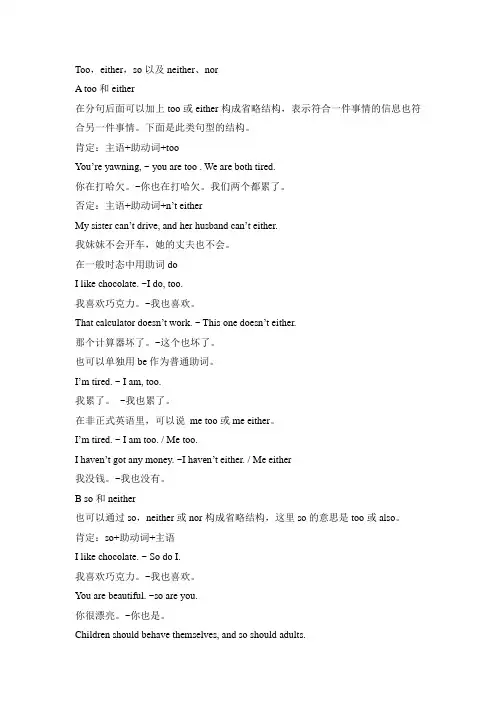
Too,either,so以及neither、norA too和either在分句后面可以加上too或either构成省略结构,表示符合一件事情的信息也符合另一件事情。
下面是此类句型的结构。
肯定:主语+助动词+tooY ou’re yawning, ~ you are too . We are both tired.你在打哈欠。
~你也在打哈欠。
我们两个都累了。
否定:主语+助动词+n’t eitherMy sister can’t drive, and her husband can’t either.我妹妹不会开车,她的丈夫也不会。
在一般时态中用助词doI like chocolate. ~I do, too.我喜欢巧克力。
~我也喜欢。
That calculator does n’t work. ~ This one doesn’t either.那个计算器坏了。
~这个也坏了。
也可以单独用be作为普通助词。
I’m tired. ~ I am, too.我累了。
~我也累了。
在非正式英语里,可以说me too或me either。
I’m tired. ~ I am too. / Me too.I haven’t got any money. ~I haven’t either. / Me either我没钱。
~我也没有。
B so和neither也可以通过so,neither或nor构成省略结构,这里so的意思是too或also。
肯定:so+助动词+主语I like chocolate. ~ So do I.我喜欢巧克力。
~我也喜欢。
Y ou are beautiful. ~so are you.你很漂亮。
~你也是。
Children should behave themselves, and so should adults.孩子们应该行为规矩,大人也是。
否定:neither /nor+助动词+主语My sister can’t drive, and neither/nor can he husband.我妹妹不会开车,她丈夫也不会。
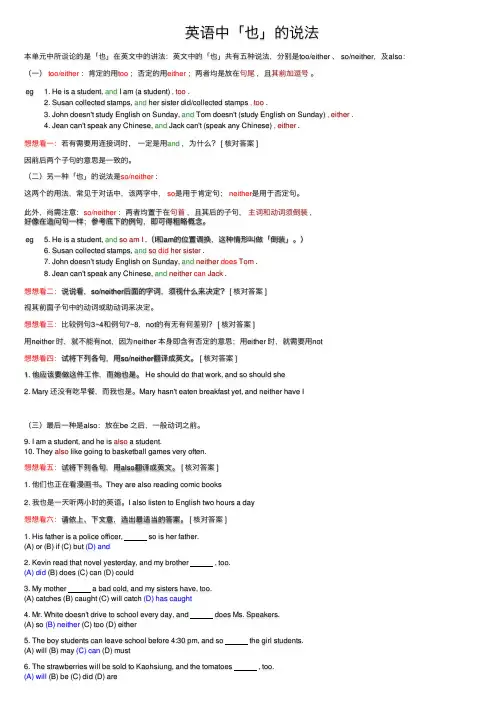
英语中「也」的说法本单元中所谈论的是「也」在英⽂中的讲法:英⽂中的「也」共有五种说法,分别是too/either 、 so/neither,及also:(⼀)too/either:肯定的⽤too;否定的⽤either;两者均是放在句尾,且其前加逗号。
eg 1. He is a student, and I am (a student) ,too .2. Susan collected stamps, and her sister did/collected stamps ,too .3. John doesn't study English on Sunday, and Tom doesn't (study English on Sunday) ,either .4. Jean can't speak any Chinese, and Jack can't (speak any Chinese) ,either .想想看⼀:若有需要⽤连接词时,⼀定是⽤and,为什么? [ 核对答案 ]因前后两个⼦句的意思是⼀致的。
(⼆)另⼀种「也」的说法是so/neither:这两个的⽤法,常见于对话中,该两字中,so是⽤于肯定句;neither是⽤于否定句。
此外,尚需注意:so/neither :两者均置于在句⾸,且其后的⼦句,主词和动词须倒装,好像在造问句⼀样;参考底下的例句,即可得粗略概念。
eg 5. He is a student, and so am I .(I和am的位置调换,这种情形叫做「倒装」。
)6. Susan collected stamps, and so did her sister .7. John doesn't study English on Sunday, and neither does Tom .8. Jean can't speak any Chinese, and neither can Jack .想想看⼆:说说看,so/neither后⾯的字词,须视什么来决定? [ 核对答案 ]视其前⾯⼦句中的动词或助动词来决定。
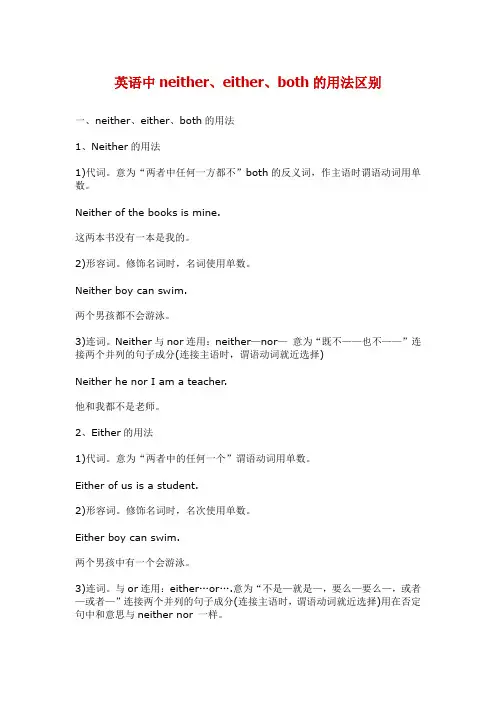
英语中neither、either、both的用法区别一、neither、either、both的用法1、Neither的用法1)代词。
意为“两者中任何一方都不”both的反义词,作主语时谓语动词用单数。
Neither of the books is mine.这两本书没有一本是我的。
2)形容词。
修饰名词时,名词使用单数。
Neither boy can swim.两个男孩都不会游泳。
3)连词。
Neither与nor连用:neither—nor—意为“既不——也不——”连接两个并列的句子成分(连接主语时,谓语动词就近选择)Neither he nor I am a teacher.他和我都不是老师。
2、Either的用法1)代词。
意为“两者中的任何一个”谓语动词用单数。
Either of us is a student.2)形容词。
修饰名词时,名次使用单数。
Either boy can swim.两个男孩中有一个会游泳。
3)连词。
与or连用:either…or….意为“不是—就是—,要么—要么—,或者—或者—”连接两个并列的句子成分(连接主语时,谓语动词就近选择)用在否定句中和意思与neither nor 一样。
Either you or I am wrong.不是你错了就是我错了。
He doesn't know Germen or French.=He knows neither German nor French.3、Both的用法1)代词。
意为“两者都”和谓语动词连用时,放在行为动词前,语法词之后。
与of 连用作主语时,谓语动词用复数。
We must both study English well.Both of us are from America.=We are both Americans.2)形容词。
修饰名词时,名次使用单数。
There are many trees on the both sides of the road.3)连词。
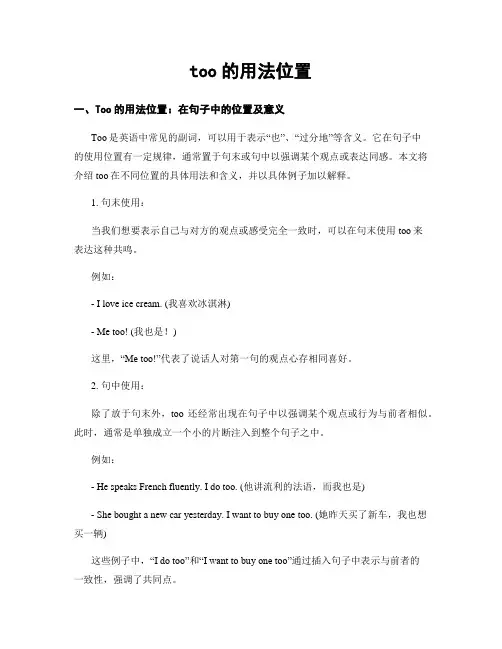
too的用法位置一、Too的用法位置:在句子中的位置及意义Too是英语中常见的副词,可以用于表示“也”、“过分地”等含义。
它在句子中的使用位置有一定规律,通常置于句末或句中以强调某个观点或表达同感。
本文将介绍too在不同位置的具体用法和含义,并以具体例子加以解释。
1. 句末使用:当我们想要表示自己与对方的观点或感受完全一致时,可以在句末使用too来表达这种共鸣。
例如:- I love ice cream. (我喜欢冰淇淋)- Me too! (我也是!)这里,“Me too!”代表了说话人对第一句的观点心存相同喜好。
2. 句中使用:除了放于句末外,too还经常出现在句子中以强调某个观点或行为与前者相似。
此时,通常是单独成立一个小的片断注入到整个句子之中。
例如:- He speaks French fluently. I do too. (他讲流利的法语,而我也是)- She bought a new car yesterday. I want to buy one too. (她昨天买了新车,我也想买一辆)这些例子中,“I do too”和“I want to buy one too”通过插入句子中表示与前者的一致性,强调了共同点。
3. 修饰形容词或副词:有时候,too也用来修饰形容词或副词,表示“过分”或“太”。
这种用法常见于否定句、疑问句或其他表达程度的句子中。
例如:- The coffee is too hot to drink. (咖啡太烫了不能喝)- She runs too slowly in the race. (她在比赛中跑得太慢)在这些例子中,too用来修饰hot和slowly,强调了程度上的过分之处。
二、使用注意事项1. 不宜连续使用:在日常交流中,连续多次使用too可能显得不自然。
可以考虑使用其他表达方式,如So do I, Neither do I等来代替以避免重复。
2. 可与also互换使用:除了使用too外,我们还可以选择使用also来表示类似的含义。
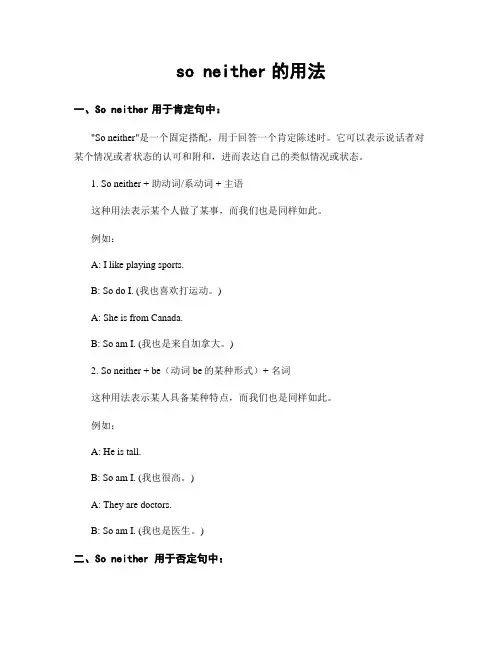
so neither的用法一、So neither用于肯定句中:"So neither"是一个固定搭配,用于回答一个肯定陈述时。
它可以表示说话者对某个情况或者状态的认可和附和,进而表达自己的类似情况或状态。
1. So neither + 助动词/系动词 + 主语这种用法表示某个人做了某事,而我们也是同样如此。
例如:A: I like playing sports.B: So do I. (我也喜欢打运动。
)A: She is from Canada.B: So am I. (我也是来自加拿大。
)2. So neither + be(动词be的某种形式)+ 名词这种用法表示某人具备某种特点,而我们也是同样如此。
例如:A: He is tall.B: So am I. (我也很高。
)A: They are doctors.B: So am I. (我也是医生。
)二、So neither 用于否定句中:"So neither"在否定句中的意思略有不同。
它可以表示两个人或者两个事物具有相同的否定特点。
1. Neither + 助动词/系动词 + 主语 + nor这种结构表达两个人或事物都没有做某件事情。
例如:A: I don't like spicy food.B: Neither do I. (我也不喜欢辣的食物。
)A: She hasn't finished her homework.B: Neither have I. (我也还没完成我的作业。
)2. Neither + be(动词be的某种形式)+ 名词 + nor这种结构表示两个人或者事物具有相同的否定特点。
例如:A: He is not happy.B: Neither am I. (我也不开心。
)A: They aren't ready.B: Neither are we. (我们也没有准备好。
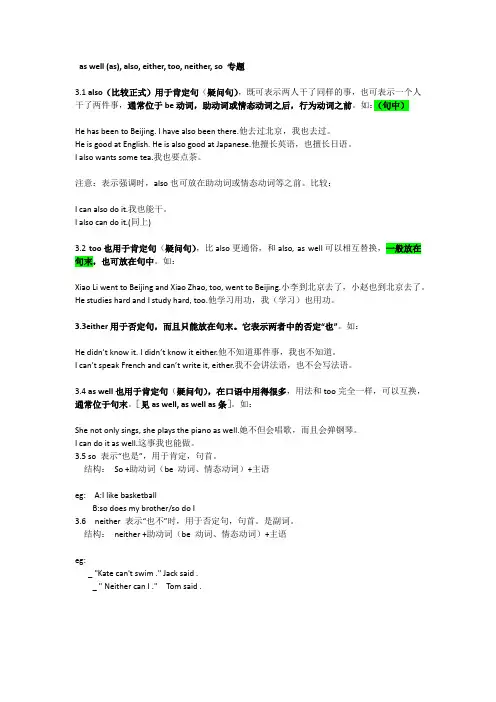
as well (as), also, either, too, neither, so 专题3.1 also(比较正式)用于肯定句(疑问句),既可表示两人干了同样的事,也可表示一个人干了两件事,通常位于be动词,助动词或情态动词之后,行为动词之前。
如:(句中)He has been to Beijing. I have also been there.他去过北京,我也去过。
He is good at English. He is also good at Japanese.他擅长英语,也擅长日语。
I also wants some tea.我也要点茶。
注意:表示强调时,also也可放在助动词或情态动词等之前。
比较:I can also do it.我也能干。
I also can do it.(同上)3.2 too也用于肯定句(疑问句),比also更通俗,和also, as well可以相互替换,一般放在句末,也可放在句中。
如:Xiao Li went to Beijing and Xiao Zhao, too, went to Beijing.小李到北京去了,小赵也到北京去了。
He studies hard and I study hard, too.他学习用功,我(学习)也用功。
3.3either用于否定句,而且只能放在句末。
它表示两者中的否定“也”。
如:He didn’t know it. I didn’t know it either.他不知道那件事,我也不知道。
I can’t speak French and can’t write it, either.我不会讲法语,也不会写法语。
3.4 as well也用于肯定句(疑问句),在口语中用得很多,用法和too完全一样,可以互换,通常位于句末。
[见as well, as well as条]。
如:She not only sings, she plays the piano as well.她不但会唱歌,而且会弹钢琴。
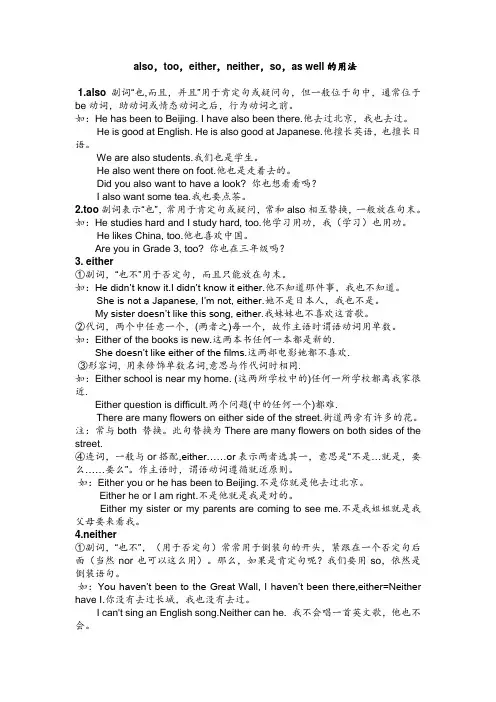
also,too,either,neither,so,as well的用法1.also副词“也,而且,并且”用于肯定句或疑问句,但一般位于句中,通常位于be动词,助动词或情态动词之后,行为动词之前。
如:He has been to Beijing. I have also been there.他去过北京,我也去过。
He is good at English. He is also good at Japanese.他擅长英语,也擅长日语。
We are also students.我们也是学生。
He also went there on foot.他也是走着去的。
Did you also want to have a look? 你也想看看吗?I also want some tea.我也要点茶。
2.too副词表示“也”,常用于肯定句或疑问,常和also相互替换,一般放在句末。
如:He studies hard and I study hard, too.他学习用功,我(学习)也用功。
He likes China, too.他也喜欢中国。
Are you in Grade 3, too? 你也在三年级吗?3. either①副词,“也不”用于否定句,而且只能放在句末。
如:He didn’t know it.I didn’t know it either.他不知道那件事,我也不知道。
She is not a Japanese, I’m not, either.她不是日本人,我也不是。
My sister doesn’t like this song, either.我妹妹也不喜欢这首歌。
②代词,两个中任意一个,(两者之)每一个,故作主语时谓语动词用单数。
如:Either of the books is new.这两本书任何一本都是新的.She doesn’t like either of the films.这两部电影她都不喜欢.③形容词, 用来修饰单数名词,意思与作代词时相同.如:Either school is near my home. (这两所学校中的)任何一所学校都离我家很近.Either question is difficult.两个问题(中的任何一个)都难.There are many flowers on either side of the street.街道两旁有许多的花。
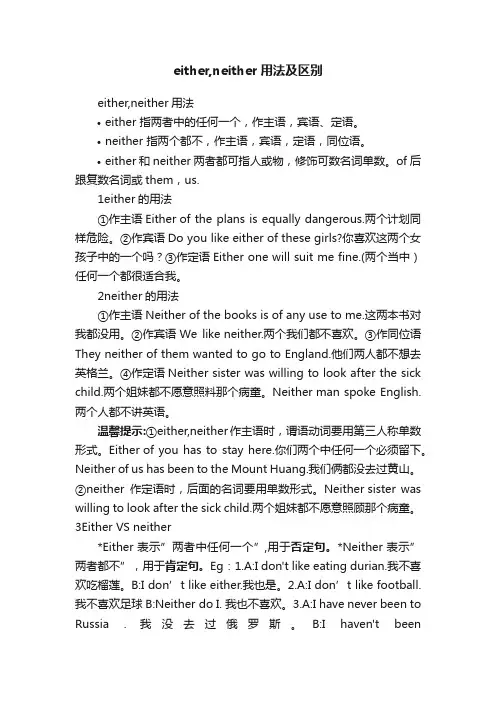
either,neither用法及区别either,neither用法•either 指两者中的任何一个,作主语,宾语、定语。
•neither 指两个都不,作主语,宾语,定语,同位语。
•either 和neither两者都可指人或物,修饰可数名词单数。
of后跟复数名词或them,us.1either的用法①作主语Either of the plans is equally dangerous.两个计划同样危险。
②作宾语Do you like either of these girls?你喜欢这两个女孩子中的一个吗?③作定语Either one will suit me fine.(两个当中)任何一个都很适合我。
2neither的用法①作主语Neither of the books is of any use to me.这两本书对我都没用。
②作宾语We like neither.两个我们都不喜欢。
③作同位语They neither of them wanted to go to England.他们两人都不想去英格兰。
④作定语Neither sister was willing to look after the sick child.两个姐妹都不愿意照料那个病童。
Neither man spoke English.两个人都不讲英语。
温馨提示:①either,neither作主语时,谓语动词要用第三人称单数形式。
Either of you has to stay here.你们两个中任何一个必须留下。
Neither of us has been to the Mount Huang.我们俩都没去过黄山。
②neither作定语时,后面的名词要用单数形式。
Neither sister was willing to look after the sick child.两个姐妹都不愿意照顾那个病童。
3Either VS neither*Either 表示”两者中任何一个”,用于否定句。
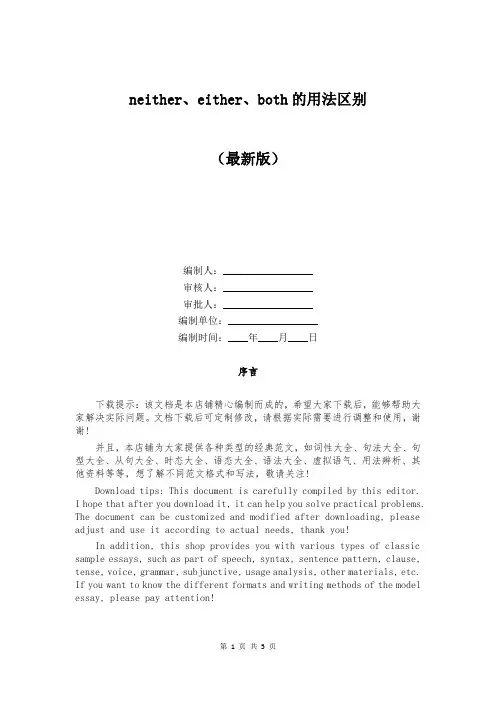
neither、either、both的用法区别(最新版)编制人:__________________审核人:__________________审批人:__________________编制单位:__________________编制时间:____年____月____日序言下载提示:该文档是本店铺精心编制而成的,希望大家下载后,能够帮助大家解决实际问题。
文档下载后可定制修改,请根据实际需要进行调整和使用,谢谢!并且,本店铺为大家提供各种类型的经典范文,如词性大全、句法大全、句型大全、从句大全、时态大全、语态大全、语法大全、虚拟语气、用法辨析、其他资料等等,想了解不同范文格式和写法,敬请关注!Download tips: This document is carefully compiled by this editor.I hope that after you download it, it can help you solve practical problems. The document can be customized and modified after downloading, please adjust and use it according to actual needs, thank you!In addition, this shop provides you with various types of classic sample essays, such as part of speech, syntax, sentence pattern, clause, tense, voice, grammar, subjunctive, usage analysis, other materials, etc. If you want to know the different formats and writing methods of the model essay, please pay attention!neither、either、both的用法区别一、neither、either、both的用法1、Neither的用法1)代词。
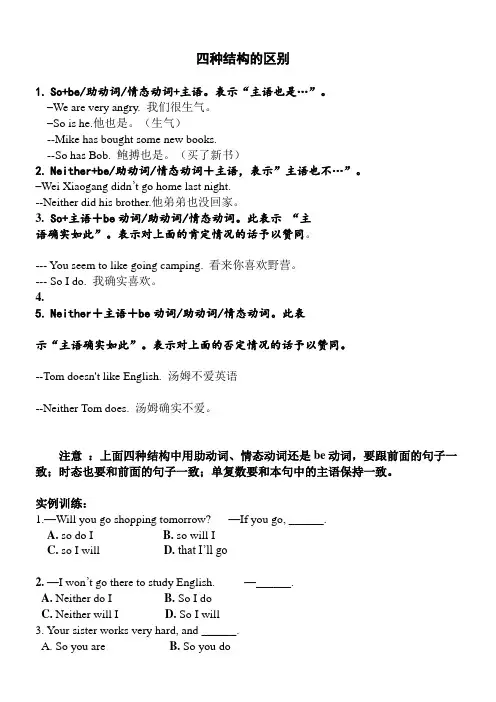
四种结构的区别1.So+be/助动词/情态动词+主语。
表示“主语也是…”。
–We are very angry. 我们很生气。
–So is he.他也是。
(生气)--Mike has bought some new books.--So has Bob. 鲍搏也是。
(买了新书)2.Neither+be/助动词/情态动词+主语,表示”主语也不…”。
–Wei Xiaogang didn’t go home last night.--Neither did his brother.他弟弟也没回家。
3.So+主语+be动词/助动词/情态动词。
此表示“主语确实如此”。
表示对上面的肯定情况的话予以赞同。
--- You seem to like going camping. 看来你喜欢野营。
--- So I do. 我确实喜欢。
4.5.Neither+主语+be动词/助动词/情态动词。
此表示“主语确实如此”。
表示对上面的否定情况的话予以赞同。
--Tom doesn't like English. 汤姆不爱英语--Neither Tom does. 汤姆确实不爱。
注意:上面四种结构中用助动词、情态动词还是be动词,要跟前面的句子一致;时态也要和前面的句子一致;单复数要和本句中的主语保持一致。
实例训练:1.—Will you go shopping tomorrow? —If you go, ______.A. so do IB. so will IC. so I willD.that I’ll go2. —I won’t go there to study English. —______.A. Neither do IB. So I doC. Neither will ID. So I will3. Your sister works very hard, and ______.A. So you areB. So you doC. So are youD. So do you4.—It wasn’t cold yesterday. —______.A. Neither it wasB. Neither it didC. So was itD. So it did5.—My parents are watching TV at home. —______.A. So do IB. So I amC. So I doD. So am I【答案】BCDAD。
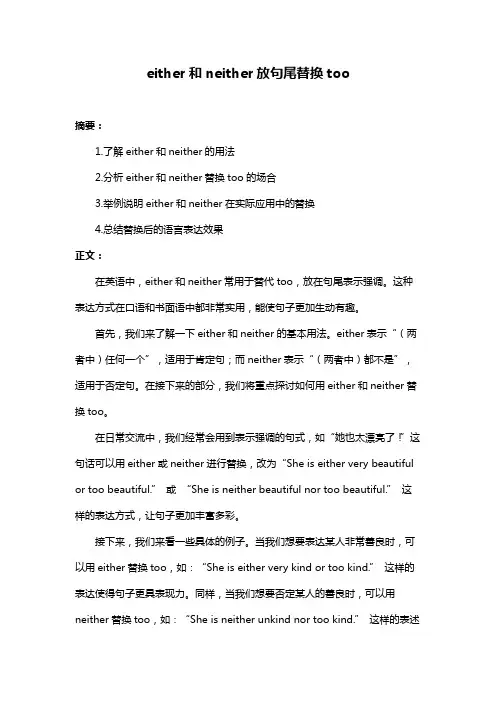
either和neither放句尾替换too摘要:1.了解either和neither的用法2.分析either和neither替换too的场合3.举例说明either和neither在实际应用中的替换4.总结替换后的语言表达效果正文:在英语中,either和neither常用于替代too,放在句尾表示强调。
这种表达方式在口语和书面语中都非常实用,能使句子更加生动有趣。
首先,我们来了解一下either和neither的基本用法。
either表示“(两者中)任何一个”,适用于肯定句;而neither表示“(两者中)都不是”,适用于否定句。
在接下来的部分,我们将重点探讨如何用either和neither替换too。
在日常交流中,我们经常会用到表示强调的句式,如“她也太漂亮了!”这句话可以用either或neither进行替换,改为“She is e ither very beautiful or too beautiful.” 或“She is neither beautiful nor too beautiful.” 这样的表达方式,让句子更加丰富多彩。
接下来,我们来看一些具体的例子。
当我们想要表达某人非常善良时,可以用either替换too,如:“She is either very kind or too kind.” 这样的表达使得句子更具表现力。
同样,当我们想要否定某人的善良时,可以用neither替换too,如:“She is neither unkind nor too kind.” 这样的表述更加婉转含蓄。
总之,在英语表达中,either和neither可以替换too,使句子更加生动有趣。
通过运用这两种词,我们可以更好地强调某人的特点,或者更加婉转地否定某人的特点。
在实际应用中,我们可以根据语境和表达需求,灵活选用either或neither进行替换。
Neither的用法归纳总结一、介绍“Neither”的含义和基本用法(400字左右)“Neither”是一个常见的英语词汇,用于表达两者之间相同或类似的否定情况。
它通常与“nor”连用,构成句子中的否定结构。
在语法上,“neither”作为形容词、代词和副词使用。
1. 形容词用法:当表示两个对象都不适用某种特征时,我们可以使用“neither + 名词 + 动词”。
例如:“Neither book is interesting.” 表示两本书都不有趣。
2. 代词用法:作为代替主语或宾语的代词,“neither”通常与倒装结构一起使用。
“Neither of us likes coffee.” 这句话意味着我们两个人都不喜欢咖啡。
3. 副词用法:作为副词,“neither”表示否定选择,表明对于两个或多个选项中的任何一个,都选择不做。
“I can't go to the party; neither can John.” 这句话表示我不能去派对,John也不能去。
二、“Neither... nor...”结构的使用方法(400字左右)“Neither...nor...”是英语中表达两者均否定情况时经常使用的结构。
它可以连接名词、代词、动词等,并且在句子中起到平衡作用。
1. 定语从句:当“neither”和“nor”出现在定语从句中时,它们用于否定两个或多个相关单词。
例如:“I found neither the book that I lost nor the pen that I borrowed.”表示我找不到我丢失的书,也找不到我借的笔。
2. 平行结构:在并列结构中,使用“neither... nor...”可以对两个事物同时表达否定。
例如:“Neither John nor Jane is attending the meeting.” 表示John和Jane都不参加会议。
3. 主谓一致:当主谓一致规则适用于“neither... nor...”结构时,动词的形态要与最接近的名词保持一致。
四种结构的区别1.So+be/助动词/情态动词+主语。
表示“主语也是…”。
–We are very angry. 我们很生气。
–So is he.他也是。
(生气)--Mike has bought some new books.--So has Bob. 鲍搏也是。
(买了新书)2.Neither+be/助动词/情态动词+主语,表示”主语也不…”。
–Wei Xiaogang didn’t go home last night.--Neither did his brother.他弟弟也没回家。
3.So+主语+be动词/助动词/情态动词。
此表示“主语确实如此”。
表示对上面的肯定情况的话予以赞同。
--- You seem to like going camping. 看来你喜欢野营。
--- So I do. 我确实喜欢。
4.Neither+主语+be动词/助动词/情态动词。
此表示“主语确实如此”。
表示对上面的否定情况的话予以赞同。
--Tom doesn't like English. 汤姆不爱英语--Neither Tom does. 汤姆确实不爱。
注意:上面四种结构中用助动词、情态动词还是be动词,要跟前面的句子一致;时态也要和前面的句子一致;单复数要和本句中的主语保持一致。
实例训练:1.—Will you go shopping tomorrow? —If you go, ______.A. so do IB. so will IC. so I willD.that I’ll go2. —I won’t go there to study English. —______.A. Neither do IB. So I doC. Neither will ID. So I will3. Your sister works very hard, and ______.A. So you areB. So you doC. So are youD. So do you4.—It wasn’t cold yesterday. —______.A. Neither it wasB. Neither it didC. So was itD. So it did5.—My parents are watching TV at home. —______.A. So do IB. So I amC. So I doD. So am I【答案】BCDAD。
我也是高级英语词汇“我也是”英文的几种表达法?我为大家搜集整理后发布的内容,让我们赶快一起来看一下吧!共有7种表达方式:1.me too2.Me either3.Me neither (用在否定句)4.so do I (我也做)5.so am I (我也是)6.I do the same thing (我也做一样的)7.I (动词) too (I like you too,I think so too,I came too)1. So do I:该结构主要用来说明前面所说的情况也同样适用于后面的人或物;意为“……也一样”该结构中的助动词 do 根据前文的情况也可换成 is, am, are, was, were, does, did, can, could 等。
2. Me too:表示的是和别人一样的意思,通常不含有动作的意味在里面。
一、双语例句so do I:You know that's true, and so do I.你知道那是真的,我也知道。
My hu *** and spends hours in the bathroom, but then again so do I.我丈夫常占用浴室好几个小时,不过我也是这样。
Lao Zhang feels , and so do I, that the characters of this novel are verywell drawn.老张认为这部小说的人物写得很成功, 我也有同感。
Me too:He always charges me too much for his goods.他总是向我索取过高的货价。
Coke for me too, please.我也要XX可乐。
neither和so的倒装句用法"Neither"和"So"是常用于表达前后两个句子之间的逻辑关系,表示一种因果关系或者对比关系。
它们的倒装用法如下:1.Neither...nor...这种结构表示“既不...也不...”,常用于否定句。
当主语和谓语之间存在表示否定的词语(如not, never, no)时,可以使用倒装句来强调否定的意思。
例如:•Neither did I see the movie, nor did I read the book.(我既没有看这部电影,也没有读这本书。
)•Neither has he called me, nor has he sent me an email.(他既没有给我打电话,也没有给我发邮件。
)在这里,主语和谓语倒置,使得句子更加强调否定的意思。
2.So...that...这种结构表示“如此...以至于...”,常用于肯定句。
当主语和谓语之间存在表示肯定的词语(如so, such, very)时,可以使用倒装句来强调肯定的意思。
例如:•So beautiful was the sunset that we stopped to take a1/ 2photo.(夕阳如此美丽,我们停下来拍照了。
)•Such was his talent that he became a famous musician at a young age.(他的才华如此出众,他在年轻的时候就成为了一位著名的音乐家。
)在这里,主语和谓语倒置,使得句子更加强调肯定的意思。
2/ 2。
too,either,also,neither的用法和区别too是副词,表示“过于,太”的含义。
1、表示否定:用于否定句中,否定句中的动词要和too放在一起。
eg. I don't like it too. 我也不喜欢。
2、表示肯定:用于肯定句中,意思是“也,而且”,表明前文的同样的意思。
eg. I like it too. 我也喜欢。
either:either也是副词,表示“也,而且”的含义。
1、表示否定:either引导的从句表示否定意思。
eg. I don't like it either. 我也不喜欢。
2、表示肯定:either引导的从句表示肯定意思,意思是“也一样,而且”。
eg. I like it either. 我也喜欢。
also:also是副词,表示“也,而且”的含义。
1、表示否定:表示从句的意思和前面的句子意思一致,表示否定意思。
eg. I didn't like it either also. 我也不喜欢。
2、表示肯定:表示前文的同样的意思,意思是“也,而且”。
eg. I like it also. 我也喜欢。
neither:neither也是副词,常与nor连用,表示“也不,而且不”的含义。
1、表示否定:neither可以单独用,也可以与nor连用,表示从句的意思和前面的句子意思一致,表示否定意思。
eg. I don't like it either neither. 我也不喜欢。
2、表示肯定:neither可以独立使用,也可以与nor连用,表示前文的同样的意思,即“也,而且”。
eg. I like it neither either. 我也喜欢。
以上就是too, either, also, neither的用法和区别。
我也是n e i t h e r,e i t h e r,t oo,s o用法精品资料Going out for dinnerSandy: Say, do you want to go out to dinner tonight?Bob: Sure. Where would you like to go?Sandy: Well, what do you think of Indian food?Bob: I love it, but I'm not really in the mood for it today. Sandy: Yeah. I'm not either, I guess. It's a bit spicy.Bob: Hmmm. How do you like Japanese food?Sandy: Oh, I like it a lot.Bob: I do, too. And I know a nice Japanese restaurant near here. Sandy: Oh, I want to go there.Bob: Terrific! Let's go!so,too,neither, either●I like Japanese food a lot.●So do I./I do,too.●Really?I don't like it very much.●I'm crazy about dessert.●So am I./I am,too.●Oh,I'm not at all.●I can eat really spicy food.●So can I./I can,too.●Oh,I can't.●I don't like greasy /food.●Neither do I./ I don't either.●Oh,I like it a lot.●I'm not in the mood for Indian food.●Neither am I./I'm not either .●Really?I am.●I can't stand fast food.●Neither can I./I can't either.●Oh,I love it!仅供学习与交流,如有侵权请联系网站删除谢谢2。